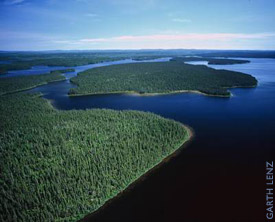Rainforests gain a lot of attention due to the amount and variety of species they support, but the world’s largest land-based biome is the Boreal Forest, aptly named after Boreas, the Greek God of the North wind. Also known as Taiga, from Russian, this concentration of trees covers much of Russia, most of Canada, Alaska, Sweden, Finland and Norway, coastal Iceland, and the northern parts of Kazakhstan, Mongolia, the U.S. and Japan representing 29 % of the world’s forest cover.

Distribution of the Boreal Forest (Wikipedia)
Largely comprised of coniferous trees, this forest supports 85 species of mammals, 130 species of fish, 300 species of birds and approximately 32,000 species of insects. Life is hard here with temperatures ranging from -65 °F (-54 °C) to 86 °F (30 °C), low precipitation (200 – 750 mm/year), 50 – 120 frost free days per year and acidic, low nutrient soils.

Alaskan spruce

Canadian wetland systems
The region also contains vast areas of wetland, bogs and fen, and the Canadian boreal region contains more rivers and lakes than any similar sized landmass in the world. Fire is a natural part of regeneration, and some trees like the lodgepole and jack pines have resin sealed cones which rely on fire to open and spread their seed.

Fire is a natural part of the regeneration cycle
This forest provides humans with enormous amounts of lumber and supports 1,400 communities in industrial activity. However, forestry practices are often still primitive in their approach, for example the practice of clearcutting in Canada removes most trees in an area only to be replanted as a monocrop (a singular species), which does not emulate a fire and is often followed by an increase in erosion.

Vast terrain with subterranean peat in western Siberia
Deforestation and oil exploration along with the processing of tar sands pose significant threats, however, climate change is the main threat to this region. The boreal forests stores huge amounts of carbon, possibly more than the temperate and tropical forests combined, with much of it in the form of peat. The boreal zone of latitude has experienced some of the greatest increase in temperatures on Earth over the last 25 years, with greater relative increases in winter temperatures than those in summer. The release of carbon, mostly in the form of methane, greatly adds to a feedback cycle of warming.

Attacks visible by the mountain pine beetle (Lorraine Maclauchlan)
Furthermore, the warmer winters lead to an increased survival of tree-damaging insects and recent years have seen forest destroying plagues of the spruce-bark beetle, the mountain pine beetle, the aspen leaf-miner, the larch sawfly, the spruce budworm and spruce coneworm. In Siberia, the boreal forest is changing from predominantly deciduous larch trees to evergreen conifers; this is also likely to accelerate warming as evergreen trees absorb more of the sun’s rays. These signs indicate that serious change is already underfoot.
But this does not mean that we should bury our heads in the sand, or imagine our individual actions to be inconsequential. Anthropomorphic warming of this planet is comprised of the activity of individuals and human minds. There may be perceptions of fear or paralysis in the comprehension of the enormity of the task required, but this is the time to act – there is no other.